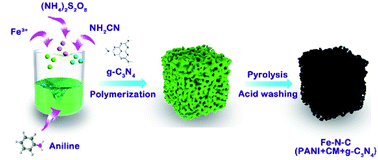当前位置:
X-MOL 学术
›
J. Mater. Chem. A
›
论文详情
Our official English website, www.x-mol.net, welcomes your
feedback! (Note: you will need to create a separate account there.)
Pore engineering of an Fe–N–C electrocatalyst to enhance the performance for the oxygen reduction reaction by adding g-C3N4 into polyaniline and cyanamide as a precursor
Journal of Materials Chemistry A ( IF 10.7 ) Pub Date : 2020/03/20 , DOI: 10.1039/c9ta13831e Zhen Sun 1, 2, 3, 4, 5 , Jinbao Lin 1, 2, 3, 4, 5 , Kun Hou 5, 6, 7, 8, 9 , Lunhui Guan 5, 6, 7, 8, 9 , Hongbing Zhan 1, 2, 3, 4
Journal of Materials Chemistry A ( IF 10.7 ) Pub Date : 2020/03/20 , DOI: 10.1039/c9ta13831e Zhen Sun 1, 2, 3, 4, 5 , Jinbao Lin 1, 2, 3, 4, 5 , Kun Hou 5, 6, 7, 8, 9 , Lunhui Guan 5, 6, 7, 8, 9 , Hongbing Zhan 1, 2, 3, 4
Affiliation

|
When designing Fe–N–C electrocatalysts as platinum group metal-free catalysts for the oxygen reduction reaction, pore engineering is crucial, in addition to creating active sites. In this study, g-C3N4 was added during the pyrolysis process of polyaniline and cyanamide, increasing the density of active sites and pore volume of the final product. The uniform distribution of atoms and relatively high ratio of pores resulted in the unprecedented electroreduction of oxygen through a 4e− pathway in acidic and alkaline media. In 0.1 M KOH solution, the half-wave potential of the modified catalyst (E1/2 = 0.912 V vs. RHE) was 50 mV more positive than that of a commercial 20% Pt/C catalyst. The durability of the catalyst was also better than that of the commercial Pt/C catalyst in acidic and alkaline media.
中文翻译:

通过在聚苯胺和氰胺中添加g-C3N4作为前驱体,对Fe–N–C电催化剂进行孔工程,以提高氧还原反应的性能
当设计Fe–N–C电催化剂作为用于氧还原反应的不含铂族金属的催化剂时,孔工程除建立活性位点外也至关重要。在这项研究中,在聚苯胺和氰胺的热解过程中添加了gC 3 N 4,从而增加了最终产物的活性位点密度和孔体积。原子和孔的相对高的比例的均匀分布导致在氧通过4E前所未有电还原-通路在酸性和碱性介质。在0.1 M KOH溶液中,改性催化剂的半波电势(E 1/2 = 0.912 V vs.RHE)比市售20%Pt / C催化剂高50 mV。在酸性和碱性介质中,该催化剂的耐久性也优于市售的Pt / C催化剂。
更新日期:2020-04-15
中文翻译:

通过在聚苯胺和氰胺中添加g-C3N4作为前驱体,对Fe–N–C电催化剂进行孔工程,以提高氧还原反应的性能
当设计Fe–N–C电催化剂作为用于氧还原反应的不含铂族金属的催化剂时,孔工程除建立活性位点外也至关重要。在这项研究中,在聚苯胺和氰胺的热解过程中添加了gC 3 N 4,从而增加了最终产物的活性位点密度和孔体积。原子和孔的相对高的比例的均匀分布导致在氧通过4E前所未有电还原-通路在酸性和碱性介质。在0.1 M KOH溶液中,改性催化剂的半波电势(E 1/2 = 0.912 V vs.RHE)比市售20%Pt / C催化剂高50 mV。在酸性和碱性介质中,该催化剂的耐久性也优于市售的Pt / C催化剂。











































 京公网安备 11010802027423号
京公网安备 11010802027423号